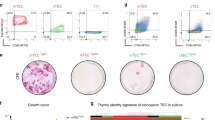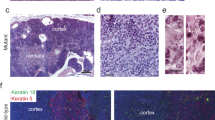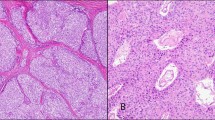Abstract
Thymoma is the most common tumor of the anterior-superior mediastinum. We have identified a line of transgenic mice which spontaneously and heritably develop thymomas at a very high penetrance. The available data suggest that thymoma formation in these mice results as a consequence of transgene insertional mutagenesis. Immune histologic analyses indicate that the thymomas are of epithelial cell origin. Survival studies indicate that tumor progression is more aggressive in females as compared to males (73.9 vs 41.7% mortality at 20 weeks of age, respectively). Fluorescent in situ hybridizations have localized the transgene integration site to the F2-G region of mouse chromosome 2. Translocation encompassing the syntenic region in humans has been implicated in lympho-epithelial thymoma. These animals may constitute a useful resource for the identification of gene(s) which participate in thymoma progression, as well as a model system for screening anti-thymoma therapeutic agents.
This is a preview of subscription content, access via your institution
Access options
Subscribe to this journal
Receive 50 print issues and online access
$259.00 per year
only $5.18 per issue
Buy this article
- Purchase on SpringerLink
- Instant access to full article PDF
Prices may be subject to local taxes which are calculated during checkout






Similar content being viewed by others
References
Battifora H, Sun TT, Bahu RM and Rao S . 1980 Human Pathology 11: 635–641.
Bloom W and Fawcett DW . 1986 Afs textbook of histology WB Saunders Company Philadelphia, PA
Botteri FM, van der Putten H, Wong DF, Sauvage CA and Evans RM . 1987 Mol Cell Biol 7: 3178–3184.
Brunner AM, Lioubin MN, Marquardt H, Malacko AR, Wang WC, Shapiro RA, Neubauer M, Cook J, Madisen L and Purchio AF . 1992 Mol Endocrinol 6: 1691–1700.
Deminatti MM, Ribet M, Gosselin B, Bauters F, Mencier E, Savary JB, Lai JL, Vasseur F, Morel P and Bisiau-Leconte S . 1994 Annales de Genetique 37: 72–74.
Feng GS, Shen R, Heng HH, Tsui LC, Kazlauskas A, and Pawson T . 1994 Oncogene 9: 1545–1550.
Fero ML, Rivkin M, Tasch M, Porter P, Carow CE, Firpo E, Polyak K, Tsai LH, Broudy V, Perlmutter RM, Kaushansky K and Roberts JM . 1996 Cell 85: 733–744.
Gulick J, Subramaniam A, Neumann J and Robbins J . 1991 J Biol Chem 266: 9180–9185.
Heng HH, Squire J and Tsui LC . 1992 Proc Natl Acad Sci USA 89: 9509–9513.
Heng HH and Tsui LC . 1993 Chromosoma 102: 325–332.
Hogan B . 1994 Manipulating the mouse embryo Cold Spring Harbor Laboratory Press Plainview, NY
Lewis JE, Wick MR, Scheithauer BW, Bernatz PE and Taylor WF . 1987 Cancer 60: 2727–2743.
Matani A and Dritsas C . 1973 Arch Path 95: 90–101.
Matsuyama M, Matsuyama T, Ogiu T and Kojima A . 1988 Jap J Cancer Res 79: 1031–1038.
Moll J, Eibel H, Schmid P, Sansig G, Botteri F, Palacios R and van der Putten H . 1992 Eur J Immunol 22: 1587–1594.
Murakumo Y, Takahashi M, Arakawa A, Saito M, Amo H, Katoh H and Matsuyama M . 1993 Jap J Cancer Res 84: 838–840.
Murakumo Y, Takahashi M, Sharma N, Arakawa A, Saito M, Amo H and Matsuyama M . 1996 Mammalian Genome 7: 505–508.
Reddy VB, Thimmappaya B, Dhar R, Subramanian KN, Zain BS, Pan J, Ghosh PK, Celma ML and Weissman SM . 1978 Science 200: 494–502.
Robles AI, Larcher F, Whalin RB, Murillas R, Richie E, Gimenez-Conti IB, Jorcano JL and Conti CJ . 1996 Proc Natl Acad Sci USA 93: 7634–7638.
Sambrook J, Fritsch EF and Maniatis T . 1989 Molecular cloning Cold Spring Harbor Laboratory Press Cold Spring Harbor, NY
Seiki K and Sakabe K . 1997 Arch Hist Cytol 60: 29–38.
Acknowledgements
We thank He Wang and Dorothy Field for excellent technical assistance, and Drs Laura Pajak and Kishore Pasumarthi for comments on the manuscript. This work was supported by the NHLBI (LJ Field), by a grant from Bristol-Myers Squibb, and by the William P Loehrer Family Fund.
Author information
Authors and Affiliations
Rights and permissions
About this article
Cite this article
Nakajima, H., Nakajima, H., Soonpaa, M. et al. Heritable lympho-epithelial thymoma resulting from a transgene insertional mutation. Oncogene 19, 32–38 (2000). https://doi.org/10.1038/sj.onc.1203266
Received:
Revised:
Accepted:
Published:
Issue date:
DOI: https://doi.org/10.1038/sj.onc.1203266
Keywords
This article is cited by
-
Establishment and characterization of a novel cell line derived from human thymoma AB tumor
Laboratory Investigation (2012)



